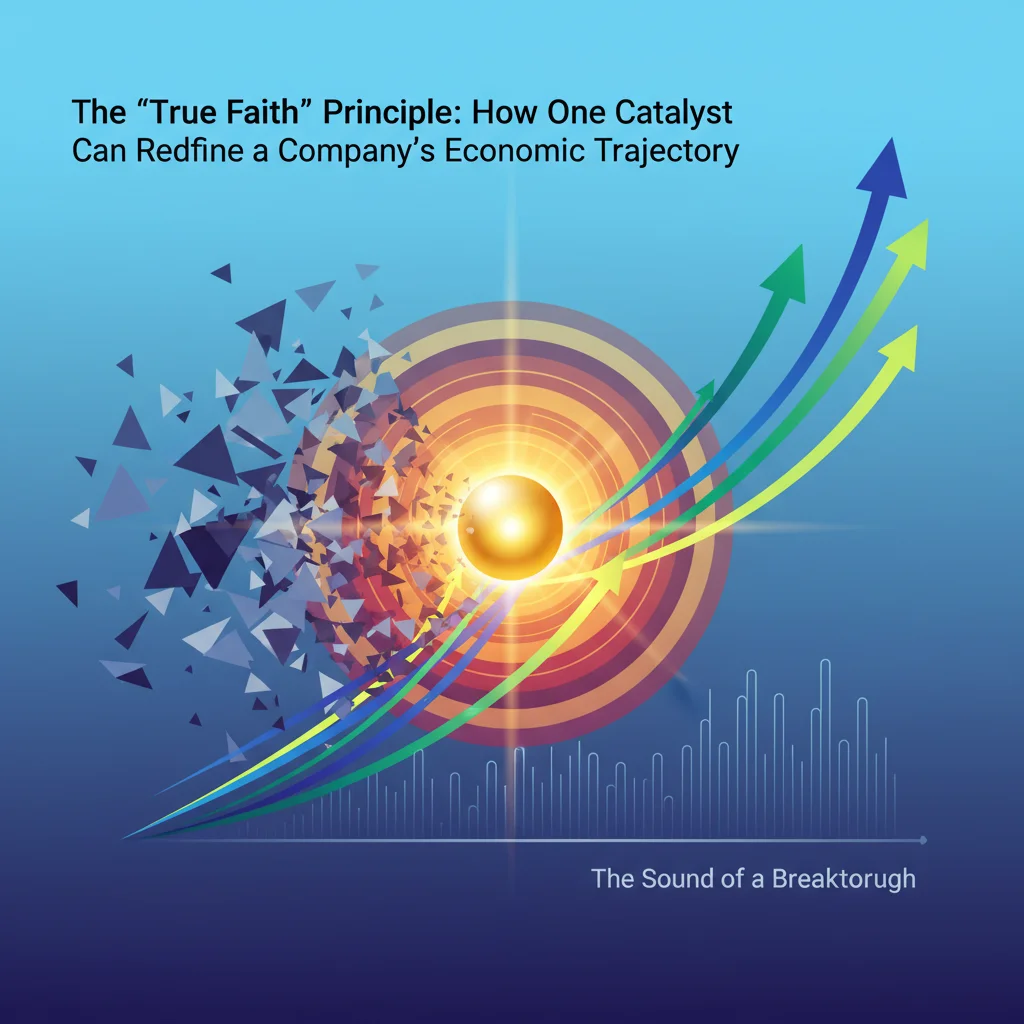
The ‘True Faith’ Principle: How One Catalyst Can Redefine a Company’s Economic Trajectory
The Sound of a Breakthrough
In 1987, the airwaves were dominated by a sound that was at once melancholic and euphoric. It was a track built on a foundation of pulsating sequencers, a soaring, almost ethereal vocal line, and a cryptic narrative of change and reflection. That song was “True Faith” by New Order, and as the Financial Times recently noted, it was more than just a hit—it was a “much-needed boost,” a pivotal moment that redefined the band’s trajectory. Emerging from the post-punk shadows of their previous incarnation, Joy Division, New Order had already established themselves as critical darlings. But “True Faith” was different. It was a catalyst.
This single event propelled them from an influential Manchester band to global pop icons, demonstrating a powerful principle that extends far beyond the recording studio. In the worlds of finance, business, and investing, organizations often face similar inflection points. They possess a solid history and a core product, but require a single, transformative catalyst—a “True Faith” moment—to break through to the next level of growth and market dominance. This principle of the catalytic event is a critical concept for business leaders navigating disruption and for investors seeking to identify the next market-defining opportunity.
From Post-Punk to Pop Juggernaut: The Anatomy of a Catalyst
To understand the power of a catalyst, we must first appreciate the context. New Order was born from tragedy, formed by the surviving members of Joy Division after the suicide of lead singer Ian Curtis. Their early work was layered with the melancholic echoes of their past. By the mid-1980s, they had a loyal following but were at a commercial and creative crossroads. “True Faith” was a conscious pivot. It embraced new financial technology in the form of advanced synthesizers and samplers, and its slick production by Stephen Hague polished their sound for a broader, mainstream audience.
This move wasn’t a rejection of their identity but an evolution. It leveraged their inherent melodic genius while packaging it in a way that captured the global zeitgeist. The result was their first American Top 40 hit and a permanent place in the synth-pop pantheon. This strategic shift holds powerful lessons for modern corporations:
- Embracing New Technology: Just as New Order harnessed the latest in music production, today’s market leaders are those who effectively integrate disruptive technologies. The rise of fintech, for example, is a direct parallel, where innovative firms are using AI, machine learning, and blockchain to fundamentally reshape the landscape of traditional banking and finance.
- Strategic Pivoting, Not Abandonment: The song still sounded like New Order, but it was a more accessible, confident version. Similarly, successful corporate pivots build upon core competencies. When Netflix moved from DVDs to streaming, it leveraged its existing customer data and recommendation engine. It was a change in delivery, not a change in its fundamental mission to entertain.
- Capturing the Market Moment: “True Faith” landed at the perfect time, as electronic music was dominating global charts. In the stock market, timing is paramount. Companies that launch the right product at the right time—think Nvidia pivoting its powerful GPUs toward the nascent AI boom—can unlock exponential growth. According to reports from Reuters, Nvidia’s strategic focus on AI data centers caused its revenue forecasts to surge by over 50%, a clear example of a catalyst igniting market euphoria.
Identifying these moments before they are obvious to the entire market is the holy grail of growth investing. It requires a deep understanding of a company’s fundamentals, its industry, and the broader macro-economics at play.
The 16Arlington Playbook: Decoding the ROI of Strategic Partnerships in a Volatile Economy
The Melancholy and Euphoria of Market Disruption
The original article astutely describes “True Faith” as a mix of “melancholy and euphoria.” This duality is a perfect metaphor for the process of disruptive innovation. The “melancholy” represents the painful but necessary act of leaving the old model behind. It’s the cost of restructuring, the risk of failure, and the uncertainty that plagues any significant strategic shift. For a legacy bank, it’s the anxiety of cannibalizing its branch-based business to build a digital-first platform. For a manufacturer, it’s the challenge of retooling factories for a new, unproven product line.
The “euphoria,” of course, is the payoff. It’s the explosive revenue growth, the surging stock price, the capture of market share, and the industry-wide recognition that follows a successful transformation. This is the phase where a company transitions from a risky bet to a blue-chip leader. The table below illustrates this transition from the “melancholy” of the legacy state to the “euphoria” of the new, catalyzed model.
Table: Anatomy of a Catalytic Shift in Business
| Business Metric | Legacy Model (The “Melancholy” of the Past) | Disruptive Model (The “Euphoria” of the Future) |
|---|---|---|
| Revenue Streams | Reliant on a single, maturing product line. | Diversified, with high-growth income from new ventures. |
| Market Position | Incumbent, defensive, losing share to agile competitors. | Market leader, innovator, setting the industry agenda. |
| Technology Stack | Dated, legacy systems requiring high maintenance. | Modern, scalable architecture (e.g., cloud, AI-driven). |
| Investor Perception | Viewed as a stable but low-growth “value” stock. | Seen as a high-growth, innovative “must-own” stock. |
| Economic Moat | Based on brand and distribution, but eroding. | Based on network effects, proprietary technology, and data. |
Building an Enduring Legacy: Beyond the One-Hit Wonder
“True Faith” was not a fluke. It was the beginning of New Order’s most commercially successful period, paving the way for the critically acclaimed album Technique and cementing their status as pioneers who could bridge the gap between indie credibility and pop success. The catalyst was powerful because it was integrated into a long-term vision. The band continued to innovate, tour, and build upon the new global audience “True Faith” had earned them. A recent concert review from The Guardian highlights their enduring appeal, calling them a “band still in their prime,” a testament to their ability to build on that 1987 breakthrough.
This is a crucial lesson for the business world. A catalytic event, such as a blockbuster product launch or a game-changing acquisition, is only as valuable as the company’s ability to capitalize on it. Apple’s iPhone was a catalyst, but its true genius lay in building the App Store ecosystem around it, creating a deep, sustainable economic moat. Amazon’s AWS was a brilliant internal solution, but the catalyst was the decision to turn it into a commercial service, which now underpins a significant portion of the global internet and Amazon’s profitability. A report by Statista shows AWS revenue growing from $3.1 billion in 2013 to over $80 billion in 2022, demonstrating the immense long-term value of a well-executed strategic expansion.
The FT article mentions that no cover version of “True Faith” has ever matched the original’s power. This speaks to the concept of first-mover advantage and authenticity. Competitors can copy a product or a feature, but they can’t replicate the unique combination of culture, timing, and vision that creates a true breakthrough. For investors, this means looking beyond the initial spike in a company’s trading volume after a positive announcement. The real analysis lies in assessing whether the company has the leadership, culture, and strategic plan to turn a single hit into a legacy of market leadership.
Beyond the Sandbox: Decoding the Investment Signals in Children's Technology
The Enduring Rhythm of Innovation
The enduring appeal of “True Faith” lies in its timeless capture of a moment of profound change—a feeling of looking back with a touch of sadness while surging forward with unstoppable optimism. This is the very rhythm of progress in the modern economy. Every great leap forward in business, investing, and technology is accompanied by this same blend of risk and reward, of melancholy for what is lost and euphoria for what is gained.
The “True Faith” principle serves as a powerful framework for understanding and identifying transformative change. For business leaders, it is a call to be bold, to embrace new technologies, and to have the courage to pivot toward the future. For investors, it is a reminder that the greatest returns are often found not in the established giants, but in those well-positioned companies on the verge of their own “True Faith” moment—a single, powerful catalyst that will change their trajectory forever.


